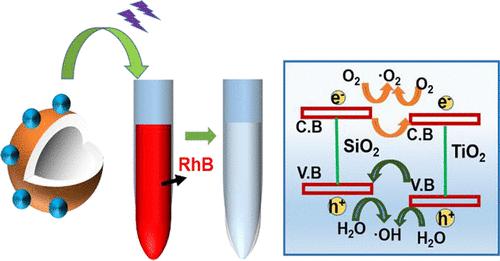当前位置:
X-MOL 学术
›
ACS Appl. Nano Mater.
›
论文详情
Our official English website, www.x-mol.net, welcomes your
feedback! (Note: you will need to create a separate account there.)
Hollow TiO2–SiO2 Nanospheres for Photocatalytic Degradation of Organic Dyes
ACS Applied Nano Materials ( IF 5.3 ) Pub Date : 2024-01-18 , DOI: 10.1021/acsanm.3c04783 Dongming Xu 1 , Haomiao Yu 1 , Yang Qin 1 , Yang Di 1 , Hongbing Jia 2 , Fengsheng Li 1 , Jie Liu 1
ACS Applied Nano Materials ( IF 5.3 ) Pub Date : 2024-01-18 , DOI: 10.1021/acsanm.3c04783 Dongming Xu 1 , Haomiao Yu 1 , Yang Qin 1 , Yang Di 1 , Hongbing Jia 2 , Fengsheng Li 1 , Jie Liu 1
Affiliation

|
Water pollution is a serious problem in both developed and developing countries. Several methods have been used to purify wastewater, among which photocatalytic decomposition is widely used to purify organic pollutants in wastewater. In this work, hollow nanospheres of titanium dioxide TiO2 were first prepared by the carbon sphere template method and sol–gel method, and then, the hollow nanospheres of titanium dioxide (TiO2) were compounded with silicon dioxide (SiO2) by the impregnation method to generate complexes with different ratios of hollow nanoparticles of titanium dioxide and silicon dioxide. The best degradation performance of the h-TiO2/SiO2 photocatalytic materials was achieved when the ratio of h-TiO2 to SiO2 used was 5:1. The cyclic decomposition efficiency of the 5:1 h-TiO2/SiO2 composites showed only a slight change in the photocatalytic capacity compared to the first cycle, thus ensuring the durability of the samples. However, quenching experiments yielded that hydroxyl radicals play a major role in the degradation process, and possible reaction mechanisms are discussed in detail. The high photocatalytic performance of the environmentally friendly h-TiO2/SiO2 nanosphere photocatalysts makes them ideal for water purification applications and offers potential applications for the utilization of solar energy to effectively reduce environmental pollution. The h-TiO2/SiO2 nanophotocatalysts can not only degrade dyes but can also be valuable for self-cleaning glass applications.
更新日期:2024-01-18































 京公网安备 11010802027423号
京公网安备 11010802027423号